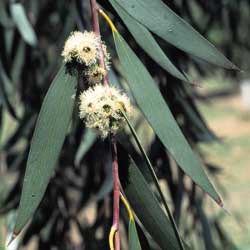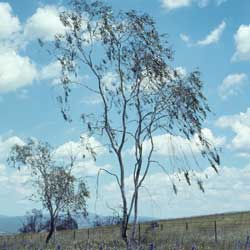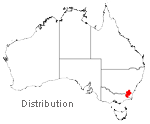Eucalyptus lacrimans
 |
 |
Weeping Snow Gum
Eucalyptus lacrimans L.A.S.Johnson & K.D.Hill (1991)
Eucalyptus lacrimans , commonly known as the Adaminaby Snow Gum or the Weeping Snow Gum, grows with distinctive pendulous branches, growing to a height of 15 m and attaining a spread of 12 m. Its main attraction is its slender weeping branches and pendulous leaves, as well as the attractiveness of stems, bark and foliage. The leaves are shiny, grey-green, lance-shaped and about 12 cm in length. The flowers are white.
Myrtaceae, the family to which Eucalyptus belong, is a group of very attractive, adaptable and hardy plants suitable for cultivation in a wide range of situations. This species was only described in 1991 and is considered rare in Australia due to a limited distribution. Eucalyptus lacrimans was originally considered a subspecies of E. pauciflora and the two species are likely to hybridise in their natural environment.
 It is endemic to the area around Adaminaby in the south-eastern part of New South Wales where it grows on broad flat areas in more or less treeless grassy plains. In these areas the soil is poorly drained and wintering conditions are cold, with frost, snow, frozen ground and heavy mists.
It is endemic to the area around Adaminaby in the south-eastern part of New South Wales where it grows on broad flat areas in more or less treeless grassy plains. In these areas the soil is poorly drained and wintering conditions are cold, with frost, snow, frozen ground and heavy mists.
E. lacrimans is an attractive specimen tree for small gardens or ornamental plantings. It is also useful in groups for wind protection. It is an excellent tree for cold damp positions, can withstand snow and ice and grows well in poor soils. It is very long-lived, is very slow growing and can easily be cultivated from seed.
In its natural state it can grow to between 8 and 15 metres in height and may be up to 12m in width. The bark is powdery and smooth, white or grey in colour. The trunk sheds its bark in thin strips and it has beautiful weeping or pendulous branches. Its graceful and unusual form and branching habit make it an excellent ornamental or specimen tree.
Profuse flowering occurs from spring to early summer (September to January) in the wild and the fruit stays tightly packed along the stems. Its small delicate white flowers are quite attractive to people as well as birds.
This species is quite slow growing, and takes about 5 years to reach 2m height. Conditions for growth include full sun, and deep wet clay soils. Propagation is by seed, as is common with many Eucalypts, which at a temperature of 25ºC takes approximately 30 days to germinate. Cold stratification is recommended for a period of 6 weeks prior to sowing seed.
The bog method of germinating seed is recommended, where the tray or pot of growing media containing seed is placed in a shallow container of water. This allows the seeds to be kept moist by capillary movement of the water. Heat is not necessary although good ventilation is recommended. Seedlings should be tended for three to four months and then planted out in either spring or early autumn. After establishment this species will generally requires little maintenance.
Eucalyptus lacrimans suffers from the same pests and diseases that attack many other eucalypts. The primary concerns are leaf-eating beetles and scale, both of which may be controlled by use of low-toxicity products. Scale, if it presents a problem, is best controlled during October to November when young crawlers appear. Spraying with white oil during this time of the year usually provides control. For older mature scale it may be necessary to use a mixture of white oil and a suitable insecticide. Contact a qualified horticultural adviser or local specialists for recommendations. No evidence of fungal leaf spots or other common Eucalyptus diseases have been found.
Text by Martine Goldner (2006 Student Botanical Intern)
Photos: M.Fagg (private)
Name meaning: Eucalyptus lacrimansEucalyptus - from the Greek, eu , meaning well, and kalyptos , meaning covered, alluding to the cap or lid which covers the stamens in bud; lacrimans - from Latin, meaning weeping, in reference to the distinctively pendulous branches. |
References
Australia ’s Virtual Herbarium (2006) Available at http://www.cpbr.gov.au/avh. [Accessed: 10/2/2006].
Briggs, J.D. (1996) Rare or Threatened Australian Plants. CSIRO, Collingwood, Australia.
Brooker, M.I.H. (2000) A New Classification of the Genus Eucalyptus L’Hér. (Myrtaceae), Australian Systematic Botany 13: 79-148.
Brooker, M.I.H. & Kleinig, D.A. (1999) Field Guide to Eucalypts: Volume 1: South-eastern Australia, Bloomings Books, Hawthorn, Victoria.
Brooker, M.I.H., Slee, A.V., Connors, J.R. & Duffy, S.M. (2002) EUCLID: Eucalypts of Southern Australia CSIRO Publishing, Collingwood, Australia.
Hill K.D. & Johnson L.A.S. (1991) Systematic studies in the eucalypts – 3. New taxa and combinations in Eucalyptus (Myrtaceae), Telopea 4(2)
Eucalypt Study Group. (2006) The Eucalypt Page. Available at http://farrier.csu.edu.au/ASGAP/eucalypt.html [Accessed 2/3/2006].
PlantNET - NSW Flora Online, National Herbarium of New South Wales, Sydney Australia. Available at http://plantnet.rbgsyd.nsw.gov.au/ [Accessed: 10/2/2006].
Molyneux B. & Forrester S. (1997) The Austraflora A-Z of Australian plants. 2nd Edn, Kew & Reed.
Rigby G. & B. (2005) Successfully growing Australian native plants. Reninna Press.
![An Australian Government Initiative [logo]](/images/austgovt_brown_90px.gif)

